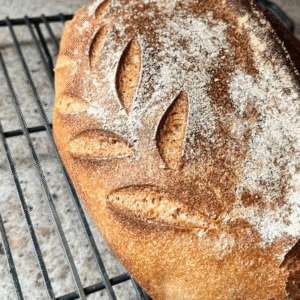
Basic Sourdough Artisan Loaf
Equipment
- 1 Food Scale
- 1 Mixing Bowl
- 1 Electric Mixer (Kitchenaid)
- 1 Banneton Basket
- 1 Dutch Oven or Baking Stone
Ingredients
- 500 grams Freshly Ground Flour You could sub all purpose or bread flour 1 for 1
- 100 grams Sourdough Starter I use mine straight from the fridge
- 375 grams Water
- 10 grams Salt
Instructions
Feed your starter the night before you plan to bake.
- Use fresh milled flour and water. Stir until it’s the consistency of thick pancake batter.
- Leave it loosely covered on the counter overnight.
Check your starter in the morning.
- If bubbly and risen, it’s ready to use.
- If not, discard half and feed again. Let it sit until active.
Mix the dough.
- In a large bowl, combine starter, filtered water, and salt. Stir until dissolved.
- Add fresh milled flour (usually a mix of hard white wheat and Kamut).
- Mix with a Danish dough whisk, then knead briefly by hand until the dough comes together.
Let the dough rest (autolyze) for about 30 minutes, covered.
Knead the dough.
- Transfer to a stand mixer and knead with the dough hook for 20–25 minutes, until smooth and soft (not sticky).
- Alternatively, knead by hand until the dough passes the windowpane test.
Bulk ferment the dough.
- Place the dough in a lightly oiled bowl, cover, and let it rise on the counter until doubled in size (this can take 8–12+ hours depending on your home’s temperature).
Shape the dough.
- Turn the dough out onto a lightly floured surface.
- Shape into a round loaf by gently kneading and pulling the dough toward you to create tension on the top.
Prepare for cold proof.
- Place the shaped dough top-side down into a floured banneton basket.
- Put the basket inside a plastic grocery bag or wrap loosely with a towel.
- Refrigerate for at least 12–24 hours (or up to 4–5 days).
Bake the bread.
- Preheat the oven to 475°F with a Dutch oven inside.
- When fully preheated, remove the dough from the fridge and gently turn it out onto parchment paper.
- Place the dough (on parchment) into the hot Dutch oven.
- Cover with the lid and bake for 20 minutes.
- Remove the lid and bake another 20 minutes until golden brown.
Cool the loaf on a wire rack.
- Let cool completely for best slicing… or dig in while it’s warm (no judgment!).
Notes
- If your kitchen is cold, bulk fermentation may take longer—watch for dough doubling and bubbles.
- If using a baking stone, add a tray of hot water to create steam.
- For a lighter crust, tent the bread with foil after removing the lid.